Att leva i stim
Många djur lever tillsammans i grupper. När fiskar gör det kallas det för stim. Andra ord för när djur lever i grupp är flock, hjord, skock och svärm. Trots att det heter olika saker är det oftast samma syfte med det sättet att leva, det har nämligen flera fördelar!
Ett stort stim med sardiner.
Bild: Colourbox
Gnuer lever i flock på savannen.
Bild: David-Ryder-Colourbox
En stor flock med starar.
Bild: Jørgen-Flemming-Colourbox
Vandringsgräshoppor förflyttar sig i stora svärmar på Madagaskar.
Bild: Iwoelbern-CC-BY-SA
Skydd mot rovdjur
Den främsta fördelen med att leva i stim är skyddet mot rovdjur. Det är svårt för ett rovdjur att urskilja en individ i ett stort stim med fiskar. Rovdjuret vet inte var det ska fästa blicken och blir förvirrat. Att leva i stim minskar också stressnivån för de fiskar som gör det. En fisk som kommer ifrån sin grupp blir mer stressad vid fara än vad den fisk som är kvar i sitt stim får. Det gör också att det är lättare för en fisk i stim att återhämta sig efter att faran är över.
Pirayor lever, och jagar, i stim.
Bild: Andrey-Armyagov-Colourbox
Flerhornig hammarhaj är en av vissa hajarter som jagar tillsammans i stim.
Bild: Xvic-CC-BY-SA
Jaga tillsammans
Det är också lättare att jaga i grupp än på egen hand, även om det är fler munnar som ska mättas. Att leva i stim gör också att det är lättare att hitta en partner att para sig med, i jämförelse med hur det är för djur som lever ensamma.

Rödbukspiraya
Pygocentrus nattereri
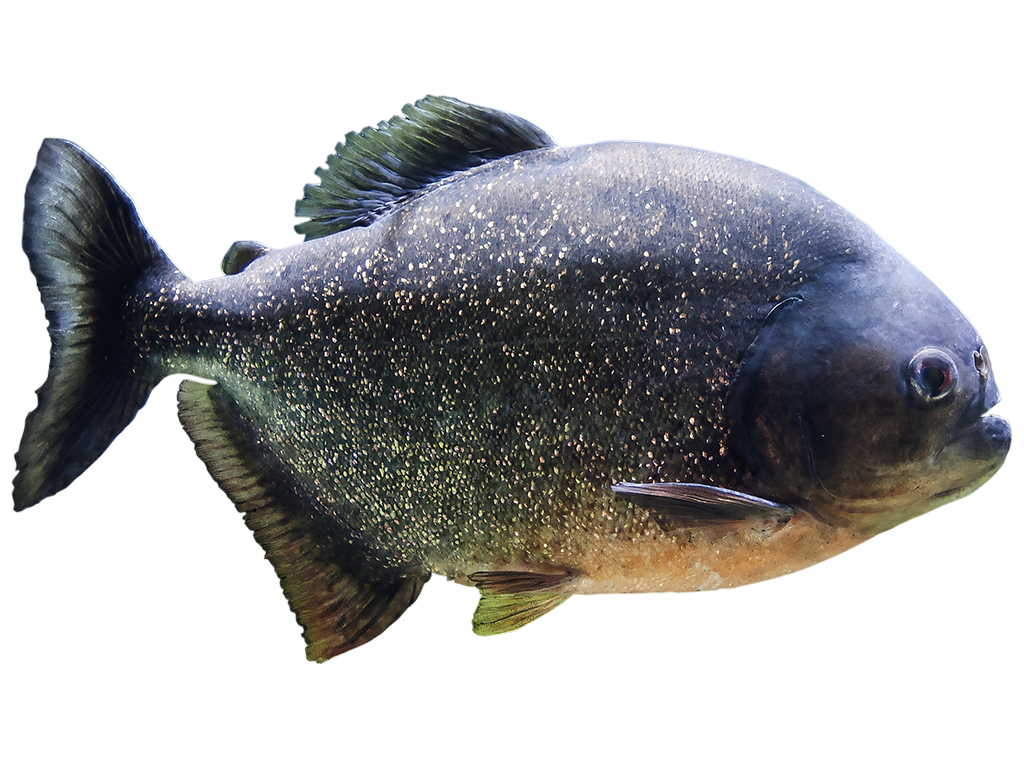
Missförstådd fegis
Rödbukspirayan är kanske en av jordens mest missförstådda fiskar. Den allmänna uppfattningen om rödbukspirayan är att det är mycket blodtörstig fisk som i stora grupper inte drar sig för att attackera enorma byten och slita dem i stycken. Sanningen är att rödbukspirayan är en mycket försiktig fisk, som främst äter redan döda djur, men också insekter, växter och en och annan bit av varandra. Det är inte ovanligt att se rödbukspirayor som blivit av med delar av fenor eller fjäll i ett slagsmål. Men rödbukspirayan har ett fantastiskt läkkött.
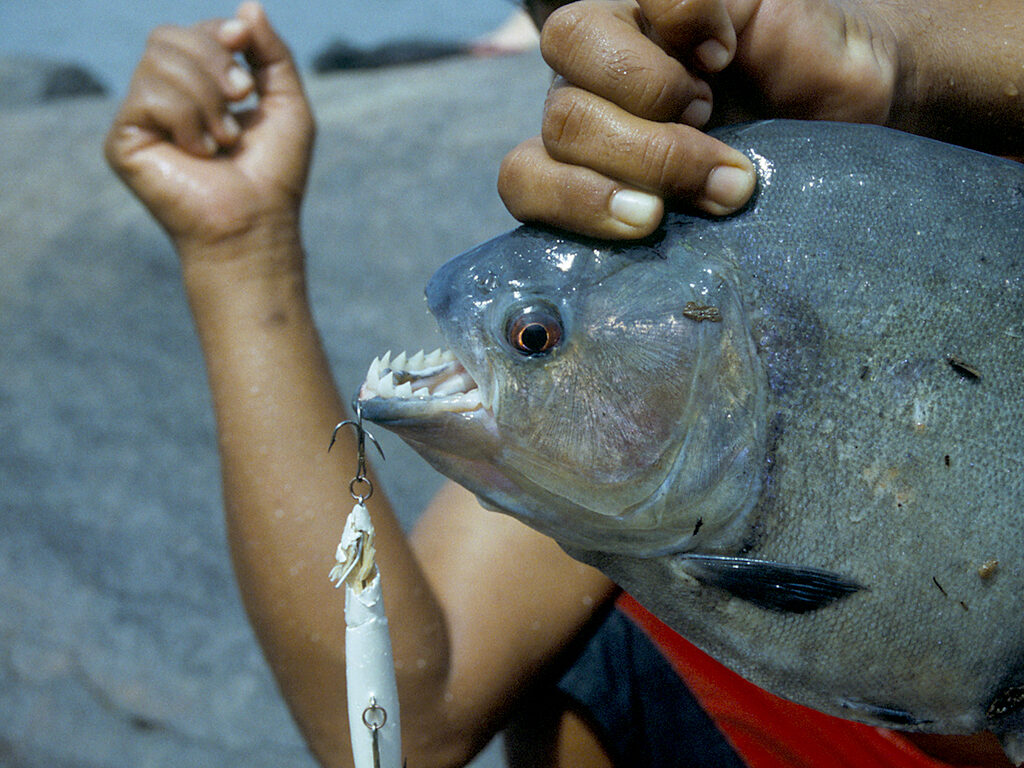
Bild: Magnus-Pettersson-Malmö-Museer
Kommunicerar med ljud
Det har hänt att grupper av pirayor attackerat och dödat stora bytesdjur, inklusive människor. Då är det mycket speciella omständigheter, där pirayorna är väldigt många, stressade, och inte har ätit på väldigt länge. Anledningen till att pirayorna lever i stora stim är alltså inte för att de jagar tillsammans, utan för att skydda sig från större rovdjur som delfiner, kajmaner eller rovfiskar.
Rödbukspirayan kommunicerar mycket med varandra inom gruppen. De har muskler i kroppen som kan framkalla ljud. De har också ett mycket välutvecklat luktsinne, som gör att de kan hitta sjuka och döende bytesdjur att äta.
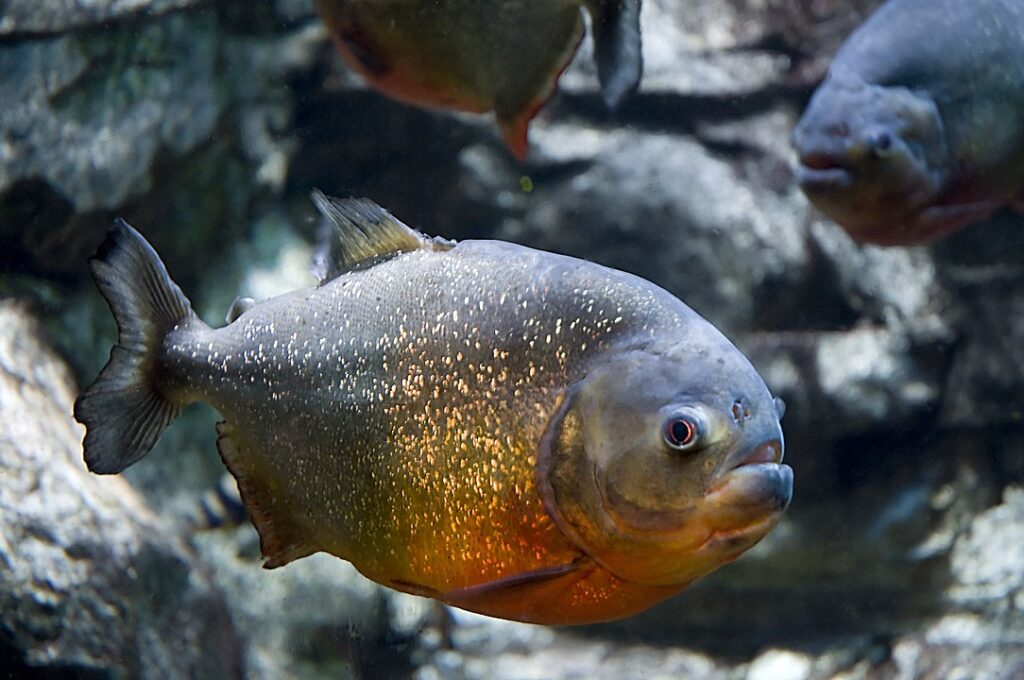
Bild: Gregory-Moine-CC-BY
Parningsdans
Under regnperioden, när vattennivåerna höjs, är det dags för rödbukspirayan att föröka sig. Hanen bygger ett slags bo bland sjögräs. Honan och hanen simmar tillsammans i en slags parningsdans innan äggen läggs. Äggen vaktas noga av både honan och hanen, och kläcks efter 2-3 dagar. När ynglen kläckts gömmer de sig bland växtlighet och fortsätter vaktas av föräldrarna tills de är stora nog att klara sig själva.
Utbredningsområde i världen

Tropiska delarna
av Sydamerika
Vit markering = Utbredningsområde
Hotstatus enligt Rödlistan

Reglerad inom handel
CITES: Ej listad.
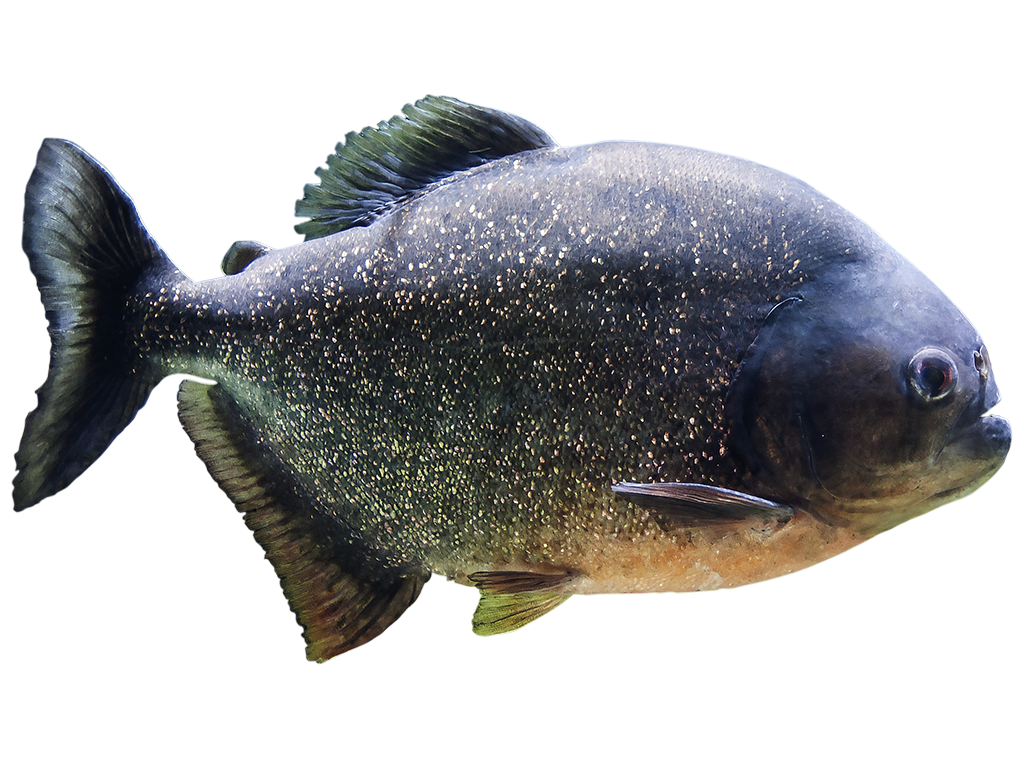
Vad är Rödlistan?
Rödlistning är ett sätt att bedöma om olika djur- och växtarter är utrotningshotade utifrån kriterier som hur många djur eller växter som finns av arten och hur utbredda de är. En nationell rödlistning bedömer artens risk att dö ut inom ett lands gränser. Den internationella rödlistningen bedömer artens risk att dö ut över hela jorden.
Läs mer

Om rödlistning i Sverige: Artdatabanken, www.artdatabanken.se
Om rödlistning i världen: International Union for Conservation of Nature, IUCN, www.iucn.org

Vad är CITES?
För att bekämpa olaglig handel med djur och växter finns en internationell överenskommelse om handel, som heter CITES. CITES innebär att utrotningshotade djur och växter inte får köpas eller säljas mellan olika länder utan tillstånd.
CITES klassar olika arter i olika kategorier (som kallas Appendix I, II och III) beroende på hur hotad arten är. Ju större hotet från handeln är desto högre skydd. Inom EU finns ytterligare skydd för arter i CITES. EU:s egen klassning har fyra steg: A-D.
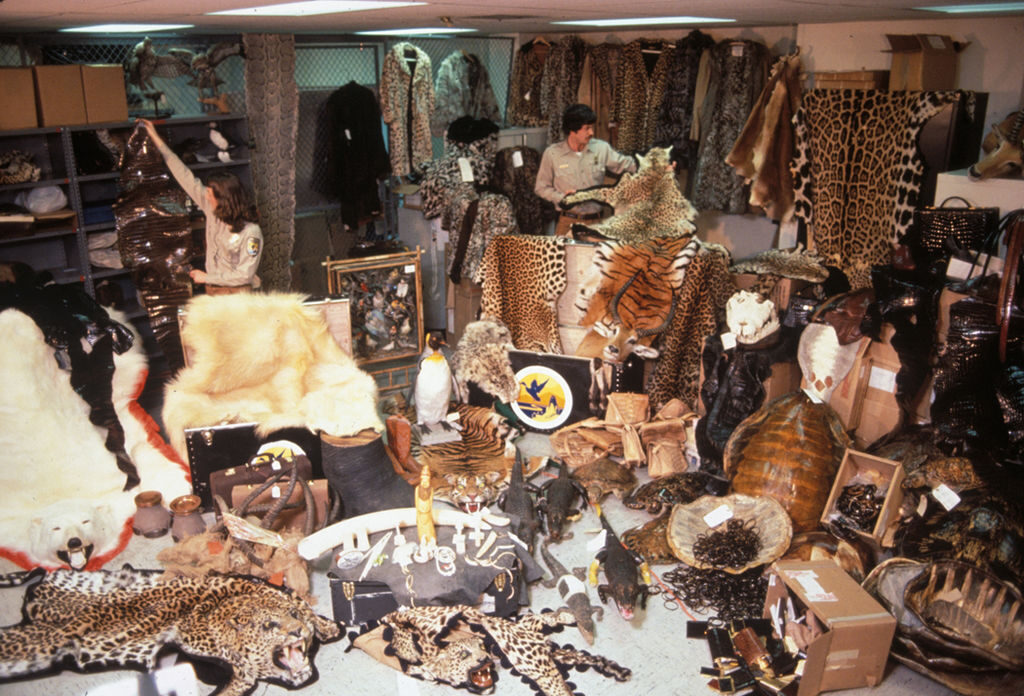
Bild: Steve-Hillebrand
Förbjudet att handla med viltfångade arter
Högst skydd mot handel har de arter som är inom kategori A och B. Här gäller oftast att handel mellan EU och övriga världen är förbjuden utan tillstånd. Arter som är CITES A eller B-klassade får inte heller köpas eller säljas inom EU om det inte kan bevisas att de har lagligt ursprung och inte fångats i det vilda.
Att använda växter eller djur för att tillverka souvenirer och annat är också förbjudet. Den som bryter mot reglerna kan dömas till böter eller fängelse.
Kontrollera spridning av arter
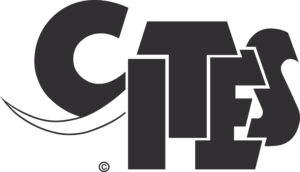
Arter som är CITES C-klassade är utrotningshotade i ett visst land men inte nödvändigtvis i hela världen. CITES D-klassning betyder att en art importeras i så stort antal att de behöver regleras för att inte riskera att sprida sig okontrollerat där de inte hör hemma.

Living together
Many animals live together in groups. When fish do this, it is called a shoal, and if the fish swim in the same direction, it is called a school. Some other words for when animals live in groups are flock, herd, gaggle and swarm. Even though the names for this way of life are different, the aim is often the same: it has several advantages!
A large school of sardines.
Photo: Colourbox
Wildebeests lives together in herds on the savannah.
Photo: David-Ryder-Colourbox
A large flock of starlings.
Photo: Jørgen-Flemming-Colourbox
Migratory locusts move in large swarms on Madagascar.
Photo: Iwoelbern-CC-BY-SA
Protection against predators
The main advantage of living in a shoal is protection against predators. It is hard for a predator to distinguish one individual in a large shoal of fish. The predator doesn’t know where to fix its gaze and gets confused. Living in a shoal also reduces the stress level for the participating fish. A lone fish that gets separated from its shoal becomes more stressed when danger threatens than the fish that stays with the shoal. This also makes it easier for the fish in the shoal to recover when the danger is over.
Piranhas live and hunt together in shoals.
Photo: Andrey-Armyagov-Colourbox
The Scalloped Hammerhead shark is one of a few species of shark that hunt together in shoals.
Photo: Xvic-CC-BY-SA
Hunting together
It’s also easier to hunt in a group than by yourself, even though this means there are more mouths to feed. Living in a shoal also makes it easier to find a partner to mate with, compared with what it’s like for fish that live alone.

Red-bellied Piranha
Pygocentrus nattereri

Misunderstood coward
The red-bellied piranha is perhaps one of the most misunderstood fish on the planet. The general opinion about the red-bellied piranha is that it is a very bloodthirsty fish that hunts in large groups and do not hesitate to attack huge prey and rip them apart. The truth is that the red-bellied piranha is a very cautious fish that mainly eats cadavers, but also insects, plants, and the occasional nibble of each other. It is not unusual to see red-bellied piranhas that have lost pieces of their fins or scales in a fight. But the red-bellied piranha has an amazing ability to heal.

Photo: Magnus-Pettersson-Malmö-Museer
Communicates through sounds
Occasionally, groups of piranhas do attack and kill large prey, including humans. But this only happens under very special circumstances, when the piranhas form a large group, are stressed, and have not eaten in a very long time. The reason why the piranhas live in large schools is not that they hunt together, but because it is a great way to protect themselves from larger predators like dolphins, caimans, or predatory fish.
Red-bellied piranhas communicate a lot within the group. They have muscles that can produce sounds. They also have a very keen sense of smell, allowing them to locate sick and dying prey to eat.

Photo: Gregory-Moine-CC-BY
Mating dance
During the wet season, when water levels rise, it is time for the red-bellied piranha to spawn. The male builds a kind of nest among seaweed. The male and female then dance together in a kind of mating dance before the eggs hatch. The eggs are carefully guarded by both parents, and they hatch after 2–3 days. When the fry hatch, they hide among the water plants and are guarded by the parents until they are large enough to make it on their own.
Distribution worldwide

Tropical parts in
South America
White marking = Distribution
Threat based on the Red List

Trade regulations
CITES: Not listed.

What is the Red List?
The Red List is a way to assess whether different animal and plant species are at risk of extinction based on criteria such as how many animals or plants of a species exist and how widely distributed they are. A national Red List assesses a species’ risk of dying out within national borders. The international Red List assesses a species’ risk of dying out worldwide.
Read more

About the Red List in Sweden: The Swedish Species Information Centre (Artdatabanken), www.artdatabanken.se/en/
About the Red List worldwide: The International Union for Conservation of Nature (IUCN), www.iucn.org

What is CITES?
CITES (the Convention on International Trade in Endangered Species of Wild Fauna and Flora) is a treaty that makes it illegal to buy or sell animals and plants that are at risk of extinction between countries without a permit.
CITES classifies species into different categories (called Appendix I, II and III) depending on how endangered each species is. In addition, the more the species is threatened by international trade, the higher its level of protection. Within the EU, CITES-listed species are further classified and protected by the EU’s own classification system. This has four Annexes, from A to D.

Photo: Steve-Hillebrand
Ban on trading wild-caught species
The highest protection against trade is given to CITES-listed species included in the EU’s Annexes A and B. Usually this means that trade between the EU and the rest of the world is illegal without a permit. There is also a ban on trading these species within the EU unless it can be proved that they have a lawful origin and were not caught in the wild.
It is also forbidden to use plants or animals to make souvenirs etc. Anyone who breaks these regulations can be fined or imprisoned.
Controlling the spread of species

CITES-listed species that are in the EU’s Annex C are classified as endangered in at least one country but not necessarily in the whole world. An Annex D classification means that individual members of a species may be imported to the extent that they do not need to be regulated to avoid any risk of them spreading uncontrollably where they do not belong.
